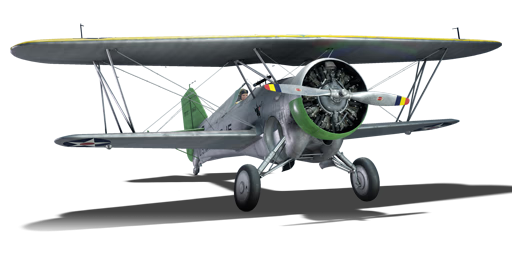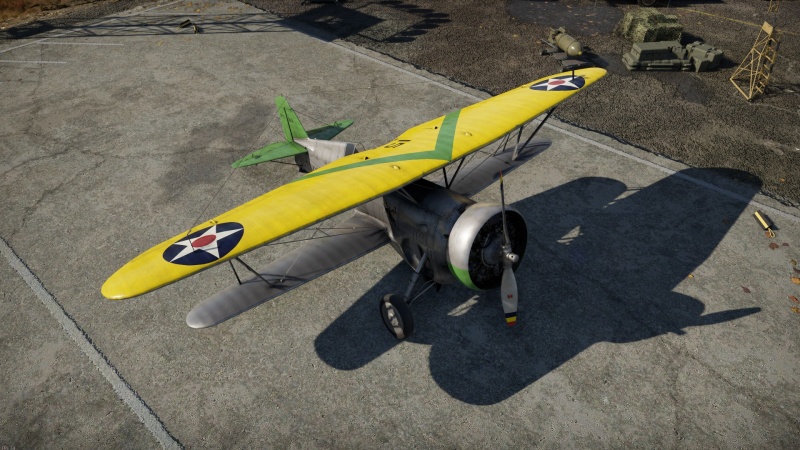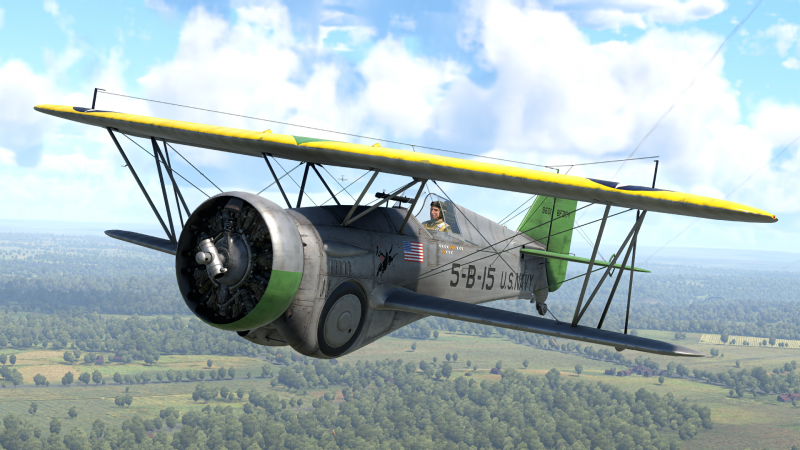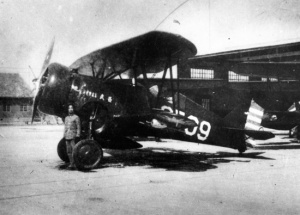Difference between revisions of "BF2C-1"
(→Description) (Tag: Visual edit) |
(History & Media.) (Tag: Visual edit) |
||
| Line 6: | Line 6: | ||
== Description == | == Description == | ||
<!-- ''In the description, the first part should be about the history of and the creation and combat usage of the aircraft, as well as its key features. In the second part, tell the reader about the aircraft in the game. Insert a screenshot of the vehicle, so that if the novice player does not remember the vehicle by name, he will immediately understand what kind of vehicle the article is talking about.'' --> | <!-- ''In the description, the first part should be about the history of and the creation and combat usage of the aircraft, as well as its key features. In the second part, tell the reader about the aircraft in the game. Insert a screenshot of the vehicle, so that if the novice player does not remember the vehicle by name, he will immediately understand what kind of vehicle the article is talking about.'' --> | ||
| − | The | + | The '''{{Specs|name}}''' is a rank {{Specs|rank}} American fighter {{Battle-rating}}. It was introduced in [[Update "La Royale"]]. |
A carrier-based biplane fighter available to new players as a reserve. It has the peculiarity of being the only reserve biplane (and reserve plane overall) in the game with a retractable landing gear, giving it an advantage when it comes to aerodynamics. | A carrier-based biplane fighter available to new players as a reserve. It has the peculiarity of being the only reserve biplane (and reserve plane overall) in the game with a retractable landing gear, giving it an advantage when it comes to aerodynamics. | ||
| Line 127: | Line 127: | ||
* Does not turn as well as nearly all other biplanes | * Does not turn as well as nearly all other biplanes | ||
| − | == History == | + | == History<ref>https://en.wikipedia.org/wiki/Curtiss_BF2C_Goshawk</ref> == |
<!-- ''Describe the history of the creation and combat usage of the aircraft in more detail than in the introduction. If the historical reference turns out to be too long, take it to a separate article, taking a link to the article about the vehicle and adding a block "/History" (example: <nowiki>https://wiki.warthunder.com/(Vehicle-name)/History</nowiki>) and add a link to it here using the <code>main</code> template. Be sure to reference text and sources by using <code><nowiki><ref></ref></nowiki></code>, as well as adding them at the end of the article with <code><nowiki><references /></nowiki></code>. This section may also include the vehicle's dev blog entry (if applicable) and the in-game encyclopedia description (under <code><nowiki>=== In-game description ===</nowiki></code>, also if applicable).'' --> | <!-- ''Describe the history of the creation and combat usage of the aircraft in more detail than in the introduction. If the historical reference turns out to be too long, take it to a separate article, taking a link to the article about the vehicle and adding a block "/History" (example: <nowiki>https://wiki.warthunder.com/(Vehicle-name)/History</nowiki>) and add a link to it here using the <code>main</code> template. Be sure to reference text and sources by using <code><nowiki><ref></ref></nowiki></code>, as well as adding them at the end of the article with <code><nowiki><references /></nowiki></code>. This section may also include the vehicle's dev blog entry (if applicable) and the in-game encyclopedia description (under <code><nowiki>=== In-game description ===</nowiki></code>, also if applicable).'' --> | ||
| − | '' | + | The United States Navy and Curtiss felt that the F11C-2 possessed development potential, and the Navy decided to procure a variant with retractable landing gear. This variant, which still had the F11C-2's classic "Hawk" wood wing with its flat-bottomed Clark Y airfoil, was designated '''XF11C-3''' by the Navy and '''Model 67''' by Curtiss. The main gear retraction system was inspired by the Grover Loening-designed system on the Grumman XFF-1 prototype, and was manually operated. |
| + | |||
| + | The XF11C-3 was first delivered to the USN in May 1933, with a Wright R-1820-80 radial engine rated at 700 hp (520 kW). Trials revealed a 17 mph (27 km/h) increase in speed over the F11C-2, but the extra weight caused a decrease in maneuverability. The Navy felt the handling degradation was more than offset by the increase in speed, however. During testing the XF11C-3 had its wood-framed wing replaced by the metal-structured, biconvex, NACA 2212 airfoil wing, and soon after was redesignated '''XBF2C-1''' (Model 67A) in keeping with the new Bomber-Fighter category. | ||
| + | |||
| + | Twenty-seven '''BF2C-1''' were ordered by the U.S. Navy, with a raised rear turtle deck, a semi-enclosed cockpit, and a metal-framed lower wing. Delivered in October 1934, they were assigned to VB-5B on the aircraft carrier USS ''Ranger'', but served only a few months before difficulties with the landing gear led to their withdrawal. In spite of its short service run, many of the innovations developed for the '''Goshawk''' line found wide use in Navy aircraft in the years that followed. They were the last Curtiss fighter accepted for service with the U.S. Navy. | ||
| + | |||
| + | The export version '''Model 68 Hawk III''' reverted to the classic wood/Clark Y wings and was powered by a 770 hp (570 kW) R-1820-F53. Chinese Hawk IIIs served as multi-purpose aircraft when combat operations against the Imperial Japanese Army and Navy Air Forces began in earnest in August 1937, particularly with the Battle of Shanghai and Nanjing, and were considered the Nationalist Chinese Air Force's frontline fighter-pursuit aircraft along with their inventory of Hawk IIs, Boeing Model 281 "Peashooters" and Fiat CR.32s. Col. Gao Zhihang scored a double-kill against the superior Mitsubishi A5M "Claude" (predecessor of the A6M "Zero") over Nanjing on 12 October, 1937 while at the controls of his Hawk III numbered "IV-I" (4th Pursuit Group, Commander). The appearance of monoplanes like the A5M shifted the balance towards the Japanese. | ||
| + | |||
| + | As the air-interdiction and close-air support for the National Revolutionary Army of China continued at the Battle of Shanghai on 14 October, 1937, the Chinese Air Force launched a major strike against Japanese positions in Shanghai with a uniquely mixed force of three Curtiss Hawk IIIs escorting three B-10s, two He 111As, five O-2MCs and five Gammas from Nanjing. These combination of attacks with the Hawk IIIs were used against both the Imperial Japanese Army and Navy Air Forces, and against both ground and naval targets with considerable success through the end of 1937, before being superseded by the better-armed and faster Polikarpov I-15 and I-16 fighters that were supplied to the Chinese Air Force through the Sino-Soviet Treaty of 1937. | ||
| + | |||
| + | In early 1935, Thailand placed an order for 24 Curtiss Hawk IIIs at a cost of 63,900 Baht each, and a manufacturing license was also bought. The first 12 Hawk IIIs were shipped to Thailand in August and the remaining 12 arrived in late 1935, which were named Fighter Type 10. A total of 50 Hawk IIIs were locally built during 1937 and 1939. The type was used against the French in the Franco-Thai War and the Japanese in December 1941, then relegated for use as trainers. Some of these aircraft were still active in 1949 and one airframe (KH-10) survives in the Royal Thai Air Force Museum. | ||
== Media == | == Media == | ||
| − | <!-- ''Excellent additions to the article would be video guides, screenshots from the game, and photos.'' --> | + | [[File:Curtiss Model 68 Hawk III.jpg|thumb]]<!-- ''Excellent additions to the article would be video guides, screenshots from the game, and photos.'' --> |
| − | ;Skins | + | ;[[File:Curtiss BF2C-1 Goshawk VB-5 NAN1-86.jpg|thumb]]Skins |
* [https://live.warthunder.com/feed/camouflages/?vehicle=bf2c_1 Skins and camouflages for the {{PAGENAME}} from live.warthunder.com.] | * [https://live.warthunder.com/feed/camouflages/?vehicle=bf2c_1 Skins and camouflages for the {{PAGENAME}} from live.warthunder.com.] | ||
Revision as of 05:44, 4 July 2024
Contents
Description
The BF2C-1 Goshawk is a rank I American fighter with a battle rating of 1.0 (AB/RB/SB). It was introduced in Update "La Royale".
A carrier-based biplane fighter available to new players as a reserve. It has the peculiarity of being the only reserve biplane (and reserve plane overall) in the game with a retractable landing gear, giving it an advantage when it comes to aerodynamics.
Furthermore, the Goshawk is also capable of providing close air support, making it a nice pick for mixed battles.
General info
Flight performance
Describe how the aircraft behaves in the air. Speed, manoeuvrability, acceleration and allowable loads - these are the most important characteristics of the vehicle.
| Characteristics | Max speed (km/h at 3,500 m) |
Max altitude (metres) |
Turn time (seconds) |
Rate of climb (metres/second) |
Take-off run (metres) | |||
|---|---|---|---|---|---|---|---|---|
| AB | RB | AB | RB | AB | RB | |||
| Stock | 397 | 384 | 10700 | 13.9 | 14.5 | 12.1 | 11.9 | 274 |
| Upgraded | 423 | 411 | 12.7 | 13.3 | 16.6 | 14.2 | ||
Details
| Features | ||||
|---|---|---|---|---|
| Combat flaps | Take-off flaps | Landing flaps | Air brakes | Arrestor gear |
| X | X | X | X | X |
| Limits | ||||||
|---|---|---|---|---|---|---|
| Wings (km/h) | Gear (km/h) | Flaps (km/h) | Max Static G | |||
| Combat | Take-off | Landing | + | - | ||
| 600 | 280 | N/A | N/A | N/A | ~12 | ~6 |
| Optimal velocities (km/h) | |||
|---|---|---|---|
| Ailerons | Rudder | Elevators | Radiator |
| < 240 | < 220 | < 350 | > 190 |
Survivability and armour
The BF2C-1 has no armoured plates. All critical systems are located ahead of the pilot. While the fuel tank is self-sealing, a good fire will bring your plane down very quickly before it has a chance to work its magic. Any engine damage reduces your speed to dangerous levels, so avoid tailing bombers and head-on attacks against fighters.
Modifications and economy
Armaments
Offensive armament
The BF2C-1 is armed with:
- 2 x 7.62 mm Browning machine guns, nose-mounted (600 rpg = 1,200 total)
Suspended armament
The BF2C-1 has 4 x 100 lb bombs, which makes it good in combined battles as CAS, but it's not recommended to take these bombs in air battles as the BF2C-1 is a very slow plane, making it even weaker in turnfights.
Usage in battles
Air Battles (AB and RB):
As with other biplanes, the BF2C-1 should be used as a turnfighter. But while this is a viable tactic against less manoeuvrable targets, you might struggle to turnfight other biplanes, which could turn better than you (for example, the Soviet biplanes). In that case, if you're engaging an opponent that's more agile than you, try to apply Boom and Zoom tactics instead.
The Goshawk can also use its four 100 lb bombs to attack ground targets in both Arcade and Realistic battles.
Mixed Battles (Tank and Naval Battles):
The BF2C-1 is an excellent pick for mixed battles. Being a fighter-bomber, it can both engage enemy aircraft and provide close air support. Most of the targets at this plane's Battle Rating are lightly armoured, so they can be easily destroyed by your bombs (boats can also be easily destroyed, but ships might require multiple bombs to be sunk).
Just remember that equipping the bombs will make your plane heavier, so if you find a major threat in the air, don't be afraid to release your bombs to make your plane lighter and efficiently engage the enemy.
Pros and cons
Pros:
- Capable of taking off and landing on aircraft carriers
- Has a retractable landing gear, unlike other reserve aircraft
- Easy to fly
- Features suspended armament, which comes in handy in mixed battles
Cons:
- Weak offensive armament
- Suspended armament requires precise hits in order to damage medium and heavily armoured targets
- Slow
- Does not turn as well as nearly all other biplanes
History[1]
The United States Navy and Curtiss felt that the F11C-2 possessed development potential, and the Navy decided to procure a variant with retractable landing gear. This variant, which still had the F11C-2's classic "Hawk" wood wing with its flat-bottomed Clark Y airfoil, was designated XF11C-3 by the Navy and Model 67 by Curtiss. The main gear retraction system was inspired by the Grover Loening-designed system on the Grumman XFF-1 prototype, and was manually operated.
The XF11C-3 was first delivered to the USN in May 1933, with a Wright R-1820-80 radial engine rated at 700 hp (520 kW). Trials revealed a 17 mph (27 km/h) increase in speed over the F11C-2, but the extra weight caused a decrease in maneuverability. The Navy felt the handling degradation was more than offset by the increase in speed, however. During testing the XF11C-3 had its wood-framed wing replaced by the metal-structured, biconvex, NACA 2212 airfoil wing, and soon after was redesignated XBF2C-1 (Model 67A) in keeping with the new Bomber-Fighter category.
Twenty-seven BF2C-1 were ordered by the U.S. Navy, with a raised rear turtle deck, a semi-enclosed cockpit, and a metal-framed lower wing. Delivered in October 1934, they were assigned to VB-5B on the aircraft carrier USS Ranger, but served only a few months before difficulties with the landing gear led to their withdrawal. In spite of its short service run, many of the innovations developed for the Goshawk line found wide use in Navy aircraft in the years that followed. They were the last Curtiss fighter accepted for service with the U.S. Navy.
The export version Model 68 Hawk III reverted to the classic wood/Clark Y wings and was powered by a 770 hp (570 kW) R-1820-F53. Chinese Hawk IIIs served as multi-purpose aircraft when combat operations against the Imperial Japanese Army and Navy Air Forces began in earnest in August 1937, particularly with the Battle of Shanghai and Nanjing, and were considered the Nationalist Chinese Air Force's frontline fighter-pursuit aircraft along with their inventory of Hawk IIs, Boeing Model 281 "Peashooters" and Fiat CR.32s. Col. Gao Zhihang scored a double-kill against the superior Mitsubishi A5M "Claude" (predecessor of the A6M "Zero") over Nanjing on 12 October, 1937 while at the controls of his Hawk III numbered "IV-I" (4th Pursuit Group, Commander). The appearance of monoplanes like the A5M shifted the balance towards the Japanese.
As the air-interdiction and close-air support for the National Revolutionary Army of China continued at the Battle of Shanghai on 14 October, 1937, the Chinese Air Force launched a major strike against Japanese positions in Shanghai with a uniquely mixed force of three Curtiss Hawk IIIs escorting three B-10s, two He 111As, five O-2MCs and five Gammas from Nanjing. These combination of attacks with the Hawk IIIs were used against both the Imperial Japanese Army and Navy Air Forces, and against both ground and naval targets with considerable success through the end of 1937, before being superseded by the better-armed and faster Polikarpov I-15 and I-16 fighters that were supplied to the Chinese Air Force through the Sino-Soviet Treaty of 1937.
In early 1935, Thailand placed an order for 24 Curtiss Hawk IIIs at a cost of 63,900 Baht each, and a manufacturing license was also bought. The first 12 Hawk IIIs were shipped to Thailand in August and the remaining 12 arrived in late 1935, which were named Fighter Type 10. A total of 50 Hawk IIIs were locally built during 1937 and 1939. The type was used against the French in the Franco-Thai War and the Japanese in December 1941, then relegated for use as trainers. Some of these aircraft were still active in 1949 and one airframe (KH-10) survives in the Royal Thai Air Force Museum.
Media
- Skins
See also
External links
| Curtiss-Wright Corporation | |
|---|---|
| Fighters | BF2C-1 |
| P-36A · Rasmussen's P-36A · P-36C · P-36G | |
| P-40C · P-40E-1 · P-40F-10 | |
| Bombers | SB2C-1C · SB2C-4 |
| Floatplanes | SOC-1 |
| Experimental | XP-55 |
| Export | H-75A-1 · H-75A-4 · H-81A-2 · ▂P-40E-1 · ␗P-40E-1 · ▄P-40F-5 Lafayette · CW-21 · Hawk III |
| ▄SB2C-5 | |
| Captured | ▀Hawk H-75A-2 |
| USA fighters | |
|---|---|
| P-26 Peashooter | P-26A-33 · P-26A-34 · P-26A-34 M2 · P-26B-35 |
| P-36 Hawk | P-36A · Rasmussen's P-36A · P-36C · ○P-36C · P-36G |
| P-39 Airacobra | P-400 · P-39N-0 · P-39Q-5 |
| P-40 | P-40C · P-40E-1 · P-40E-1 TD · P-40F-10 |
| P-43 Lancer | P-43A-1 |
| P-47 Thunderbolt | P-47D-22-RE · P-47D-25 · P-47D-28 · P-47M-1-RE · ⋠P-47M-1-RE · P-47N-15 |
| P-51 Mustang | P-51 · P-51A (Thunder League) · P-51C-10 · P-51D-5 · P-51D-10 · P-51D-20-NA · P-51D-30 · P-51H-5-NA |
| P-63 Kingcobra | P-63A-5 · P-63A-10 · P-63C-5 · ␠Kingcobra |
| Prototypes | XP-55 |
| F2A Buffalo | F2A-1 · Thach's F2A-1 · F2A-3 |
| BF2C | BF2C-1 |
| F3F | F3F-2 · Galer's F3F-2 |
| F4F Wildcat | F4F-3 · F4F-4 |
| F4U Corsair | F4U-1A · F4U-1A (USMC) · F4U-1D · F4U-1C · F4U-4 · F4U-4B · F4U-4B VMF-214 · F2G-1 |
| F6F Hellcat | F6F-5 · F6F-5N |
| F8F Bearcat | F8F-1 · F8F-1B |
| Other countries | ▃Ki-43-II · ▃Ki-61-Ib · ▃A6M2 · ▃Bf 109 F-4 · ▃Fw 190 A-8 · ▃Spitfire LF Mk IXc |








